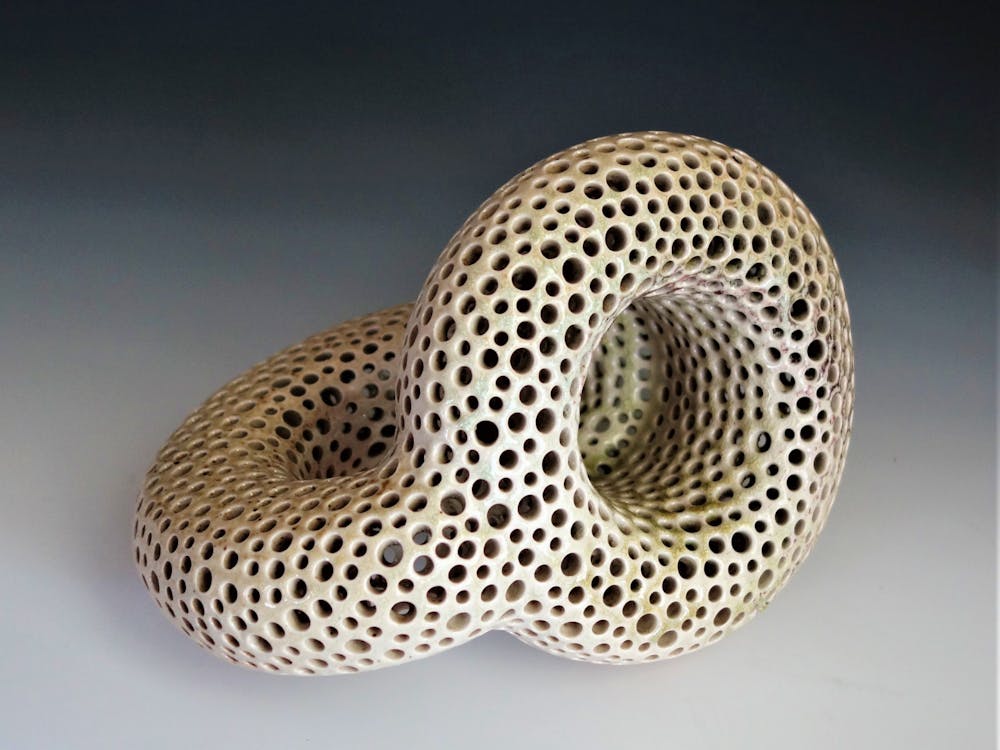From Klein bottles to community, the Triangle’s ceramics artists can build just about anything.
Many of them gather at downtown Durham’s Claymakers Arts Community, a non-profit providing resources for clay artists of all experience levels through classes, supplies, studio space and exhibitions. The foremost organization of its kind in the area, Claymakers began as a for-profit business in 2000 before transitioning to its current model.
“Certainly [it’s] the case with any art form you pick up that there’s an almost endless number of things that you can do with it, but ceramics are especially interesting because it’s just so flexible,” Executive Director Emily Lassiter said. “There is this alchemy to the process, where it’s almost kind of magical to see this humble ingredient become something really, really beautiful.”
Now lauded for its meditative qualities and unassuming utilitarianism, the ceramic arts industry fell on hard times in the late 2000s. According to Lassiter, many ceramics organizations were struggling to stay afloat at the time, but Claymakers was part of the vanguard of the medium’s eventual resurgence.
“We feel like a really special part of Durham’s art community,” Lassiter said. “We’ve kind of watched the neighborhood grow up around us. Claymakers [began] … way before Durham had this kind of renaissance. We’re really proud of the fact that we’ve been here for a while, even when times weren’t looking so great for everyone.”
The history of ceramics in North Carolina is long and storied. Seagrove, a 228-person town in Randolph County, has been a hub for ceramicists since before the American Revolution and is known as the nation’s handmade pottery capital. In its 0.7 square miles, the town boasts around 100 pottery shops. Given that clay is the state’s official art medium, Claymakers is trying to ensure that the tradition carries on in the eastern United States.
“North Carolina has a very rich history in ceramic arts, and a lot of that is centered west of us, so I think Claymakers is filling a need in the Piedmont,” said Elizabeth Paley, a potter and Claymakers community member. “I think we’re really lucky, actually, to have a place like Claymakers here, because it makes life as a potter in this area a lot easier.”
Paley, who has a master’s degree in astronomy and a Ph.D in music theory, picked up pottery in 2002 as a form of self-care while balancing a book proposal and new motherhood.
“I decided I would take three hours a week out of my schedule to learn something completely new, so I took a pottery class and it changed my life,” Paley said. “I quickly learned you cannot just spend three hours a week on it, because it draws you in too much.”
In the 18 years since, Paley has served as a member, board member and instructor at Claymakers, citing the “wonderful” community as the driving force behind her continued commitment.
Combining her interests in astronomy, music and art, much of Paley’s clay pieces are influenced by mathematical and musical considerations of proportion, balance and harmony. Inspired by one of her pottery students, Paley has taken to sculpting representations of Klein bottles, cylindrical topological spaces that only exist in the fourth dimension.
“I had actually never heard of a Klein bottle before, so I went home and looked it up and was so inspired by that shape,” Paley said. “That’s another great thing about the community — they give you a lot of great ideas.”
Lassiter hopes to extend that community to an even larger expanse of Durham in the future. While Claymakers is thriving under the revitalization of tactile, handcrafting-based art forms, Durham at large is undergoing extensive gentrification such that many arts organizations dedicated to making art accessible to all of Durham’s residents are now priced out.
“We can’t just serve affluent, gentrified Durham. [That’s] something that we’ve been discussing — we’re at a little bit of a transition point with Claymakers,” Lassiter said. “There were many years where we were kind of a scrappy, DIY, barely-making-it non-profit and now we’re at a point where we are established, we’re healthy, we’re growing.”
In their period of growth, artists’ want for space has exceeded Claymakers’ supply. Classes are in high demand, often incurring waitlists. The organization hopes to expand in the near future, making room for any and every burgeoning ceramicist in the area.
“Arts accessibility is a hard issue no matter how you slice it. There’s still people in Durham who cannot access [us], and we’d like to be able to support them,” Lassiter said. “We’re known throughout the country for the breadth and depth of our ceramic culture, so it’s really important for us to add to that tradition, providing people in Durham and the Triangle an entry point to learning more.”
Get The Chronicle straight to your inbox
Signup for our weekly newsletter. Cancel at any time.

